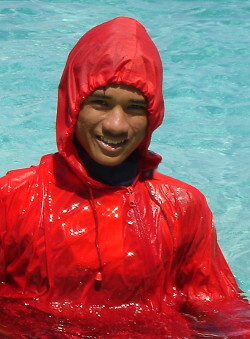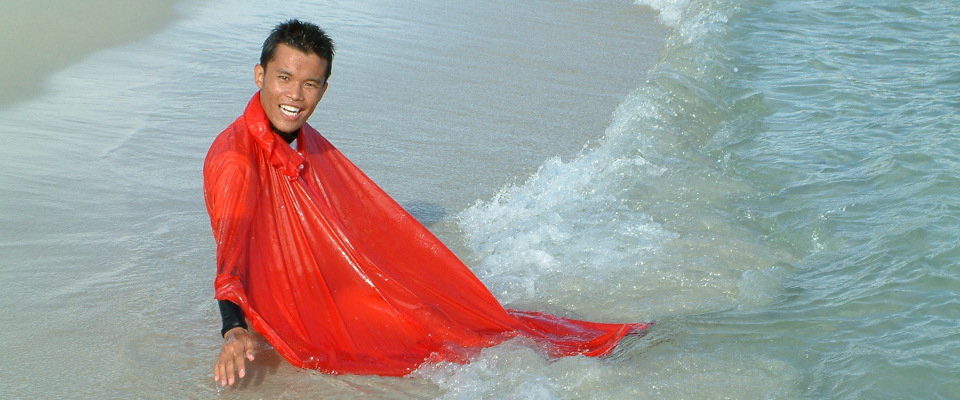Frequently Asked Sun Safety Questions
What is sun protection swimwear?
Sun safe swimwear is an alternative to sunscreens and other forms of sun protection. Many people find that sunscreen isn’t enough and it is often used incorrectly. Some people have skin allergies or sensitivities to chemicals that sunscreens can contain.
Comfy sun protection swimwear gives full body cover, looks great and form fitting, and keeps your skin safe from sunburn and jellyfish.
What is SPF and UPF?
SPF (Sun Protection Factor) and UPF (Ultraviolet Protection Factor) are standards used to measure sunburn protection. The SPF standard measures the effectiveness of sunscreens, has been around for many years.
The UPF system is relatively new and was created specially for sun protective fabrics. Use of the UPF standard is voluntary so some sun protective fabric manufactures still use the SPF system.
UPF/SPF rating indicates the length of time someone can spend outdoors without burning.
When wearing a 15 UPF garment, a person who normally burns after 20 minutes
can tolerate 15 times 20 minutes (300 minutes) without burning.
What sun protection factor has a swimsuit?
Stinger and Lycra suits can come in a number of different UPF/SPF Ratings. This will tell you the length of time you can spend exposed to direct sunlight without getting sunburn.
For example a fabric with a UPF (Ultraviolet Protection Factor) rating of 20 will allow 1/20th of UV radiation to pass through the weave. This means that your exposure to the sun would be reduced by 20 times when wearing a Lycra or swimsuit with a 20 UPF rating.
You will need to judge your own resistance to the sun (how quickly you burn) and also the suns intensity to work out which factor you need. Tests have shown that a UPF of 50+ is not actually much more effective than a UPF of 50.
If you intend to spend long periods of time in intense sunlight
then a stinger or Lycra suit with a UPF of 50 should offer the best level of protection.
Why not just swim in a T-shirt?
While a very heavy, dark, tightly-woven T-shirt may offer sun protection, most summer-weight cotton T-shirts offer as little as 10 SPF dry and lose half of their SPF when wet. The minimum UPF recommended by the American Cancer Society and others is 15.
You can layer T-shirts to increase the sun protection factor. Dark colours are better for sun protection. Wet cotton clothes feel great in hot climates when the cooling effect is most welcome. Smart people in hot regions often swim in clothes to stay cool afterwards.
What is difference to normal clothes?
UV Sun-protective fabrics differ from typical summer fabrics in several ways. They usually have a tighter weave or knit and are darker in colour. Garments made with these fabrics may have a label showing the Ultraviolet Protection Factor (UPF). The higher the UPF, the higher the UV protection.
The UPF rating indicates how much of the sun's UV radiation is absorbed by the fabric. For example, a fabric with a UPF rating of 20 allows 1/20th of the sun's UV radiation to pass through it. This means that the fabric would reduce your skin's UV radiation exposure by 20 times where it's protected by the fabric.
Can I wear these clothes in swimming pools?
Yes, absolutely. Lycra clothes are classified as swimwear. You can enjoy them in most public pools, indoor swimming centres and water parks. Bright colours make your child easy to spot!
Can my child wear it for more than one summer?
We recommend that you buy at least one size larger than your child currently wears. However, if your child is bigger than average, buy two sizes larger. Choose the right size and the all-way stretch fabric should provide you with two summers of wear before you pass it down.
Why cover up when the water is warm?
Depending on whom you ask, the answer could be comfort, modesty, sun safety and environmental protection, or simply the desire to look good in the water. You may find it's also great, pleasant fun.
According to the American Academy of Dermatology, more than 1 million people will be diagnosed with cases of skin cancer this year in the United States.
Wearing sun-protective clothing and limiting your sun exposure can reduce your risk for skin cancer.
It's important to understand the labelling information on sun
protection products and shop carefully.
Isn't just sunscreen enough?
No, they are not enough without other adequate all day UV protection. While sunscreen remains an important part of a balanced sun protection plan, many organisations such as the American Cancer Society, the Skin Cancer Foundation and the American Academy of Dermatology recommend wearing tightly-woven protective clothing because it can reduce exposure to a broad spectrum of UVA and UVB rays.
Sun lotions are only temporarily effective to protect your skin against sun damage, because the wash off every time you swim. This leaves a thin oil film on the pool surface. Coral reefs also get damaged from sun lotion.
Are swimsuits better than sunscreen?
Your swimsuit can also be your sunblock suit. Typically designed to protect against UV light, it can provide a very effective way to protect your skin against intense sunlight.
Swimsuits are much more effective than sunscreens as they do not wear off during the day or have to be reapplied. Some people are allergic to sunscreens which may also damage the skin and the environment. Swimsuits provide a good alternative protection from the sun to minimize the effects of the sun's ultraviolet rays.
How do swimsuits protect from the sun?
Stingers suits have a very tight weave fabric that helps to keep UV light from penetrating through to the skin.
They are also pre-treated with UV inhibiting ingredients to increase their protection from the sun.
Most swimsuits are designed with ventilated weaves and moisture wicking to help keep you warm and dry in hot conditions.
They can also be made with antibacterial properties to help protect your from microorganisms present in open waters.
Aren't black swimsuits hot?
Forget the myth that black is hot. The only thing hot about these outfits is the look. This is probably the most frequently asked question we get and the answer is no, they are not hot.
In fact, they were originally designed for Australia's blistering heat. The material is similar to that worn by long-distance bike riders and other athletes. While they cover more of the body, they are made of a tightly-woven, lightweight and cool material.
The American Academy of Dermatology states that "tightly-woven clothing reflects heat and helps to keep you feeling cool."
Even though swimsuits are full body designs they are actually quite cooling. This is because as water dries quickly from the material it takes heat away from your skin to keep you feeling nice and cool. If you get too warm as you dry out, go for another swim or shower and it keeps you fresh for a while.
Avoid wearing anything underneath these suits as this layering affect can make you feel a lot warmer. Wearing nothing underneath your suit will also give you a greater feeling of freedom and ease of movement.
A major advantage of Lycra fabrics is their ability to stretch to fit a wide range of body shapes and sizes. Lycra fabrics come in two varieties known as Raschel and Trico, and we feel that Trico fabrics are superior, as they will stretch equally in all directions.
These swimming clothes can be worn in and out of the water, are lightweight and made from a fast drying soft cool fabric.
If you or your kids go constantly in and out of the water you may want a fast drying nylon/lycra mix.
This modern fabric is designed for swimwear and retains far less moisture than a cotton garment.
Because it dries so quickly you really can wear it all day,
no matter how many times you're in and out of the water.
Are these crazy sun capes effective?
Actually, yes. They may look a bit odd on the beach, but are the most versatile sun protection we've found. You can quickly throw them over your swimwear, use them as changing room, or wear them on their own. The loose fit provides good ventilation as you move around.
They are surprisingly easy to swim in, not at a fast pace, more for bathing or relaxing. If you're looking for uncomplicated water clothes to splash around in the water then sun capes are for you.


